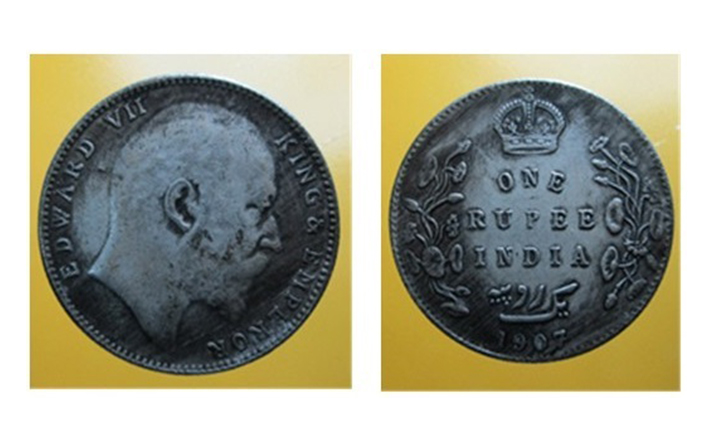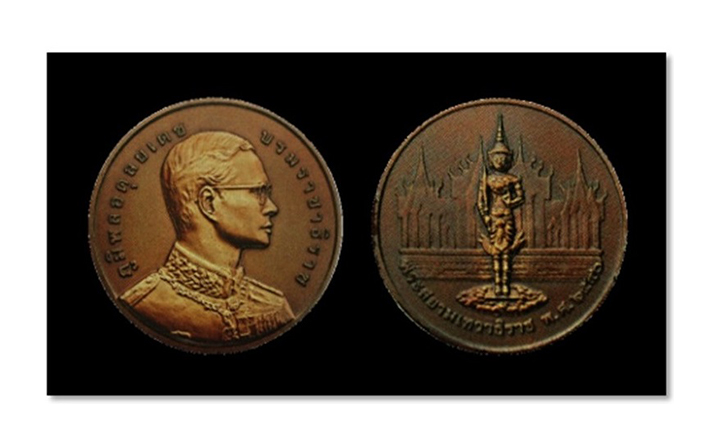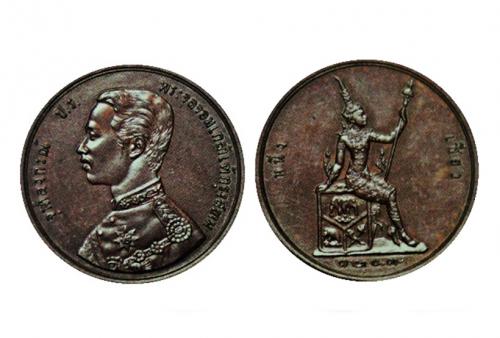Medals Commemorating the Guardian Deity of Siam, 1997 Commemorating Medal of Thai Economic History for Supporting People
Kanpop Pinyo*
It is part of human nature, that when faced with a critical situation which impacts their psyche, people historically create spiritual anchors in order to protect themselves in terms of psychological well-being. Some religions come to be because of this reason, especially religions which worship deities and other ancient or contemporary beliefs.
There are many factors that contributed to the ancient beliefs of Thai people including a multicultural society and diversity of thought. According to the historical record, the old communities in South East Asia used to believe in ghost and anchors that are not visible until they started to communicate with other regions. Hinduism and Buddhism were mixed and adapted into Thai society.
Reasons for Casting Guardian Deity of Siam
In the past, the models of tradition, including religious beliefs and practices, began in the royal palace and expanded to other areas of life. Thai kings during the Rattanakosin Era played a major role in passing these multicultural beliefs from generation to generation since the Ayutthaya or Sukothai period. Not only were Buddhism and Hinduism influenced by royal ceremony, but also animism - the belief in ghosts and gods that protect king and country.
Many serious problems occurred in Thailand during the early reign of King Mongkut or King Rama IV. One example is the military intervention by western countries which began during the reign of King Rama III. Thailand was forced to do many things. For example, Sir James Brook, the representative of British government, pressured Thailand to accept a treaty in order to stop the destruction the fortress and the occupation Bangkok. Another important event was the entrance of Lord John Hay into the Strait Settlement to attack Tranganu which was part of Thailand at that time before he gathered a navy and went to Bangkok. Lastly, one of the most important events in Thai history was the signing of the Bowring Treaty between Thailand and United Kingdom (Figure 1-2). This treaty effected the Thai economy, politics and extraterritorial rights. For example, British citizens did not have to go to Thai court if they committed crime in Thailand. All the circumstances that happened led to negative effects on the stability of the country and the people’s psyche. These could be among the reasons why King Rama IV endorsed the casting of the Guardian Deity of Siam as a spiritual anchor for himself and the Thai people. As a quote from a letter written by Princess Pilaileka Diskul to Lieutenant Colonel Sujit Tulayanon on 18th April 1972 states
"For your opinion that casting the Guardian Deity of Siam might have happened in 1859 or 1860, it could have also been in 1858 because Thailand signed trading contracts with many super power countries such as the UK ,the US and France in 1855 and 1856. There was a war between Vietnam and France in 1858 because Vietnam did not agreed to sign a contract while Thailand did not face this condition. According to this, King Mongkut endorsed the casting of the Guardian Deity of Siam when he stated that Siam (Thailand) must have a spiritual anchor that protects the country to ensure the nation’s survival into the future.”
This is also the same with the document written by Princess Poonpisamai Diskul which stated:
"King Mongkut or King Rama IV is interested in the study of history. He said that Thailand was about to lose its freedom on several occasions, but we survived. It might be because we have a deity that protects us. We should cast a statue of this deity to worship. After that, he called upon Prince Praditawarakarn to cast the statue called the Guardian Deity of Siam”
Although there is enough evidence that the Guardian Deity of Siam was cast during the reign of King Rama IV, we cannot ensure the year of the casting because that specific evidence is not found. However, Thailand has had the Guardian Deity of Siam as spiritual statue to protect the country since that time.
Figure 1: The Bowring Treatyn written in Thai Language before sending to be stamped in United Kingdom.
Source: Pramin Khruathong, King Mongkut: Old Photos during the Reign of King Mongkut, (Bangkok: Matichon, 2004) 169.
Figure 2: (Right) A drawing of Sir John Bowring
Source: Wikimedia Commons scanned it from the British Museum, United Kingdom.
From the Statue to the Diversity of Pattern
King Mongkut or King Rama IV endorsed Prince Praditawarakarn, director-general of Office of Traditional Fine Arts to cast a statue of the Guardian Deity of Siam with the feature of the eight-inch-tall standing cult image dressed as a king wearing a crown and holding a sword in the right hand while on the left hand was held at chest level with the fingers bent in the way of traditional Thai dance (Figure 3). The statue was in a Chinese castle made of sandalwood with carvings of swans and dragons. At the center of the arch were the carved Chinese letters: Fu (protect), Guo (country), Tian (god), Zen (sky). This can be translated as "This is the residence of the deity that protects the country”. At the beginning it was located in the Buddha Montian Throne Hall until the reign of King Chulalongkorn or King Rama V. Then the statue of the Guardian Deity of Siam was ordered to be removed and taken it to Thong Sam Mook Throne Hall above ‘Devaraj Mahes Door’ at Paisarntaksin Throne Hall. It remains there to this day.

Figure 3: The Guardian Deity of Siam Statue
However, building symbols that represent the Guardian Deity of Siam is not only limited to the casting of statues during the reign of King Rama IV. There are a several occasions that used this deity as a symbol of various things.
For example, during the King Rama V period in 1887, several kinds of coins were struck including Sao, Att and Solos. On the obverse side of the coins was the image of King Rama V while on the reverse side was the image of the Guardian Deity of Siam sitting on a shield that was divided into three rooms. Each room referred to the territories of Thailand at that time which were North-Central-Southern Thailand, Laos and Malaysia (Figure 4). These types of circulated coins probably served as a symbolic meaning in reference to the unity of the country. This was during the colonization period when western countries intervened in the region and sought to divide the areas in territories.
During the reign of King Bhumibol Adulyadej or King Rama IX, the Treasury Department produced medals of the Guardian Deity of Siam on two occasions; in 1997 and 1999. In addition, this deity is also used as the symbol of the Bank of Thailand. The image is similar to the one that was produced during the King Rama V period. The sitting deity is made of copper, and there is a money bag on its right hand side. This symbol has been used by the bank since 1942 (Figure 5).
Moreover, there are many organizations that use the image of the Guardian Deity of Siam for many purposes such as saints, spiritual objects or statues according to their beliefs which makes this deity popular from generation to generation.

Figure 4: A Copper Coin with a Portrait of King Rama V (obverse) - the Guardian
Deity of Siam (reverse) 1887
Source: Chaiyot Pangcharusathit, The Coinage of Siam, (Bangkok: Amarin
Printing & Publishing, 2016), 72.
Figure 5: The symbol of Bank of Thailand, The Guardina Deity of Siam...the Symbol of Bank of Thailand, cited on September 24, 2017,
Available from http://www.bot.or.th/thai/aboutbot/rolesandhistory/pages/history.aspx
In this article, we will focus on the medals of the Guardian Deity of Siam produced in 1997. This related to the important and interesting belief about this deity. The medals were struck by the Treasury Department during the economic downturn in the country. An image of the deity recalls the reason for casting the statue in the King Rama IV period when there was also an economic downturn. This kind of situation demonstrated that the purpose of striking the medals in 1997 was to uplift the spirits of the Thai people during the crisis. It might serve as historical evidence for people in the next generation to study.
History of Striking Medals during the Economic Downturn
In the middle of 1997, Thailand was at the lowest point of an economic downturn which was called the Tom Yum Kung Crisis. They had been reoccuring economic problems between 1977 and 1986 as many companies, especially Japanese, moved their production based to Thailand because of lower wages and cost of living. This led to the expansion of several business sectors including services and real estate. This situation contributed to an increase of skilled labors in companies. Because of the rapid growth on the macroeconomic level, Thailand was forced into a situation of having a policy of financial liberalization that meant financial organizations could not be allowed to collapse due to guarantees of support from the Bank of Thailand and the International Monetary Fund (IMF). During that time, Thai people engaged in risky spending behaviors such as putting money into banks that gave a high interest rate on deposits or receiving loans from financial institutions that required less credit, without studying the financial status of the these institutions. This led to the oversupply of investment in real estate that contributed to debt problems for both business owners and financial insinuations. This issue also led to the increase of the national debt.
The financial crisis in 1997, or the Tom Yum Kung Crisis, impacted Thai society both directly and indirectly. For the direct impact, many financial institutions went bankrupt, and large numbers of laborers became unemployed. An indirect impact was that many people found it necessary to move back to their hometowns. Some people suffered asset seizures. Unfortunately, many people committed suicide. The suicide rate in 1997-1998 doubled compared to previous years, and one poll showed that 17% of repondants had considered committing suicide.
Because of the financial crisis, the Treasury Department, which is responsible for striking medals for every occasion, was endorsed by King Bhumibol Adulyadej or King Rama IX to strike ‘Medals Commemorating the Guardian Deity of Siam, 1997’ to act as spiritual anchors and uplift people during the crisis.
Features of Medals Commemorating the Guardian Deity of Siam, 1997
Medals Commemorating the Guardian Deity of Siam, 1997 is the oval plain edge coins. There are two types of this coin: 50 mm. diameter frosted tone copper, and 30 mm diameter copper, both with the same figure (Figure 6).
Obverse : The portrait of King Bhumibol Adulyadej or King Rama IX, facing right with the words "Bhumibol Adulyadej” on the right edge and the word "Boromrajathiraj” on the left edge..
Designer: Mrs. Paithunsri Na Chiangmai
Engraver: Ms. Puthachat Arunvej
Reverse : Image of the Guardian Deity of Siam in front of the castle and the words: "The Guardian Deity of Siam, 1997”
Designer: Ms. Suparp Un-aree
Engraver: Mr.Wuthichai Sangngeon

Figure 6: Medals Commemorating the Guradian Deity of Siam in 1997
Source: The Treasury Department, Medals of Rattanakosin Era A.D. 1982 - 1999, (Bangkok: The Treasury Department, 2001), 259.
The Importance of Medals Commemorating the Guardian Deity of Siam, 1997
The spiritual anchors usually come with the belief in sacred objects or angels. A severe economic downturn in 1997, sometimes referred to as the Tom Yum Kung Crisis, was one of the important events that contributed to a negative impact on the Thai economy and society. It also created mental effects on people that faced this circumstance. Assumption of the feature of the Guardian Deity of Siam as a symbol on medals as a spiritual anchor can recall to the period of colonization during the reign of King Rama IV. In 1997, the Treasury Department received royal permission from King Rama IX to strike medals commemorating the Guardian Deity of Siam. All of the medals were blessed also in a merit ceremony conducted by Somdej Phrasungkaraj Sakonmahasungka Parinayok, the 19th Buddhist Patriarch of the Rattanakosin Era at Bowon Niwej Vihara Temple on 2nd September, 1998 to make them holier than before. Accordingly, medals commemorating the Guardian Deity of Siam are not only medals that recall memorable events and spiritual anchors, but also sacred objects.
From the beginning point of establishing the statue of the Guardian Deity of Siam during the reign of King Rama IV that caused by the crisis in colonization period to striking medals of the Guardian Deity of Siam during 1997 finacial crisis or Tom Yum Kung crisis demonstrates that even if it was a different situations, Thai society always has the same solution to solve problems that affect people’s minds. The same spiritual anchors are passed by generation to generation, but they differ in appearances for each occasion. Normally, commemorative medals are struck to celebrate special occasions or events. The purpose is for people to collect the medals or give them gifts. Medals commemorating the Guardian Deity of Siam 1997 are also a historical record of memorable events of the Thai economy in certain periods of time. Importantly, the medals can act as a spiritual anchor when people feel hesitant and are not sustained from the impact of the crisis.
Nowadays, the medals commemorating the Guardian Deity of Siam are displayed for international visitors and Thai citizens at the Coin Museum of the Treasury Department on Chakrabongse Road, Chana Songkram District, Phra Nakorn, Bangkok near the National Gallery and the Somdej Phra Pinklao bridge. The Coin Museum is open Tuesdays thru Sundays and on special holidays from 10.00-18.00. It is closed on Mondays.
*Curator, Practitioner Level at the Bureau of Grand National Treasure under the Treasury Department






